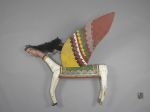Rod Puppet
About this object
History of use
A mobile stage is covered with cloths, concealing the men inside, who move the stage across the dance area. Fitted in front with a wooden animal head (an antelope or buffalo mask), the stage itself is a large puppet. The performances are organized by the village youth organizations, kamalen ton. Sogobò is organized into a series of up to twenty discrete performances separated by short intervals of song and dance. Puppet ensembles include balanin fola (small rod puppets), merekun (large rod puppets), Yayoroba (beautiful women), and maani (smaller figurative forms). The puppet heads or figures poke out from the top of the cloth frame, and are made to twirl and dance as they tower above the stage. The puppets and masks depict animals, fantastic creatures, hunters and characters from village life. Short performances focus on themes of family and village rivalry, jealously and unity, as well as masculine values and their identification with hunters. Bamana farmers and Bozo fishermen participate together in these performances now, but the oral tradition suggests puppet theater originated with the Bozo.
Narrative
Tchuemegne purchased these 20th century Sogobò puppets, textiles and frames (3420/79-100) from Mr. Amadou Fantasa, an elder from the village of Markala in central Mali, in 2019. Fantasa recalled that the puppets had been used in the biannual festivals marking the beginning of the rainy season (June), and related agricultural and fishing activities, and at the start of the dry season (Oct) to signal the coming of the grain harvest. He said the puppets had been in use from 2012-2016, but after that they were in storage. The "coming forth of the masks and puppets in Markala", frequently refered to as "Marakala Sogobò" or "Dobò", is now inscibed on UNESCO's List of Intangible Cultural Heritage.
Iconographic meaning
This puppet depicts Buraq, the mythical winged steed that carried the Prophet to heaven.
Physical description
Large white winged horse puppet, with a bright pink human head on a long neck with three neckrings, and a length of knotted fabric. The head has a headdress or helmet, has long black hair that hangs to one side, with the hair cut short on the other side. The body has a painted green saddle, with a zigzag line border in multiple colours. There is red fabric lining the chest and abdomen. The legs are attached to the body with metal plates. A pair of large, flat, detachable painted wings (parts b-c) fit into slots on the back. Each wing is red with designs in grey, green, off-white, and yellow. A carved wooden horn-like piece (part d) is detached (possibly used as a tail?).

Date Made
Before 2000
Date Acquired
5 Feb 2020
How Acquired
Sold
Credit Line
Purchase funded by the Michael O'Brian Family FoundationMore...
Measurements
Overall: 89 cm x 15 cm x 120 cm
Object Number
3420/94 a-d